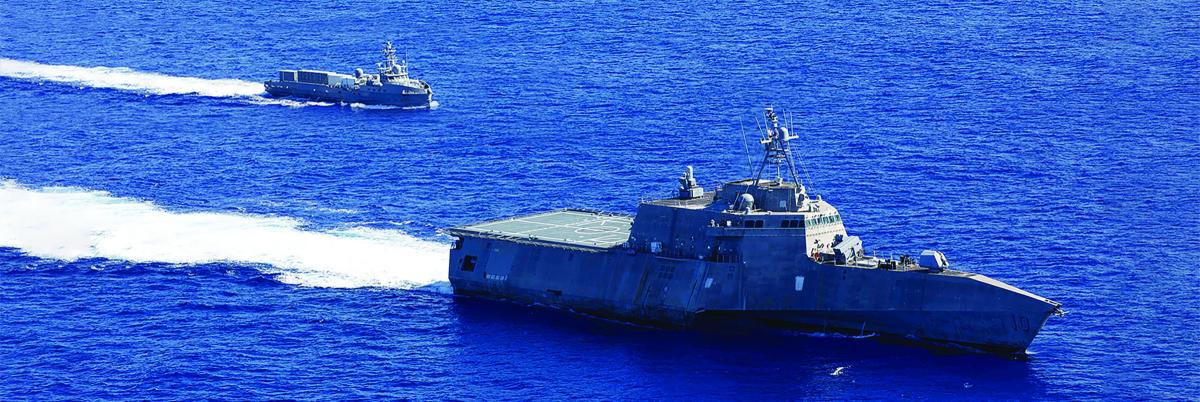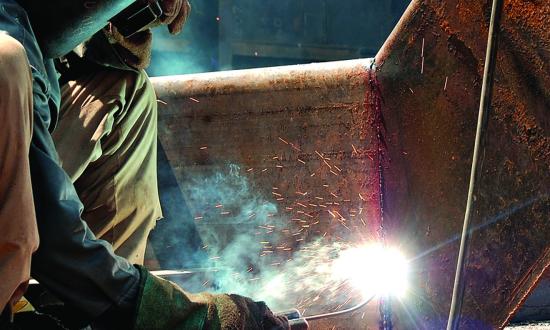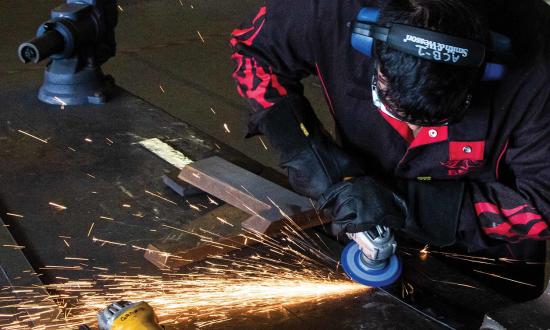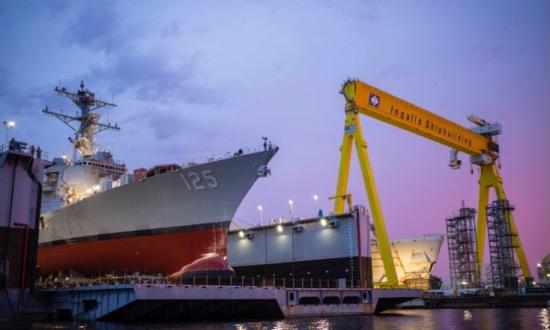The U.S. Navy and Coast Guard must collaborate on a new approach to Admiral Elmo Zumwalt’s 1970s high-low shipbuilding strategy to acquire the number of surface combatants required to maintain maritime superiority in in the 21st century. Specifically, the U.S. Sea Services must build smaller surface combatants that combine the systems and practices from littoral combat ships (LCS) and uncrewed surface vessels (USV), the proven Navy weapon systems installed in larger destroyers, and Coast Guard naval architecture and engineering plants used with high-endurance cutters.
Joint High-Low Shipbuilding Strategy
Four problems drive the need for a joint high-low shipbuilding strategy. First, in the event of a war with China, the Navy will need more destroyers in the Indo-Pacific, while the Coast Guard needs more cutters to fulfill its present-day missions and to augment the Navy tomorrow. Second, U.S. ship production must increase to compete with China. Third, the newest Coast Guard Legend- and Heritage-class cutters must have the same surface and antisubmarine warfare systems as the decommissioned Hamilton- and older Famous-class cutters. Finally, decades of live-fire exercises and ship scraping have left the Navy’s inactive ship maintenance facilities with no inventory of ships suitable for restoration and modernization.
A potential solution could see the Navy and Coast Guard adopting a rebooted version of Admiral Zumwalt’s 1970s high-low shipbuilding strategy. During the Cold War, Zumwalt had the Navy acquire less expensive vessels such as Pegasus-class hydrofoils and Oliver Hazard Perry–class frigates to bolster the Navy’s numbers against the growing Soviet Navy. Today, the United States could design and build ships small enough to be made at the LCS and cutter shipyards. These ships would be reliable and seaworthy for the Coast Guard, fitted for a variety of existing weapon and combat systems, and capable of embarking the personnel necessary to perform more Navy and Coast Guard peacetime and wartime missions that large USVs (LUSV) and medium USVs (MUSV) cannot.
Zumwalt’s high-low shipbuilding strategy used modern weapon systems to deliver lethality and capability in smaller and more affordable vessels manufactured at smaller shipyards and in large numbers. RGM-84 Harpoon antiship missiles, Mk-13 Phalanx close-in weapon systems (CIWS), the more compact Mark 13 guided-missile launching system (GMLS) and SM-1 standard surface-to-air missile, SH-2 Seasprite Light Airborne Multipurpose System (LAMPS) antisubmarine helicopter, and uncrewed OTO Melara Mk-75 76-mm gun helped make the smaller Pegasus- and Oliver Hazard Perry–class vessels viable in high-end warfighting in the 1970s. Although less capable than the larger and more expensive Spruance-class destroyers built in the 1970s, the Oliver Hazard Perry class provided U.S. and foreign navies with a relatively lower-cost ship equipped with modern air-defense, antiship, and antisubmarine warfare (ASW) capabilities.
The Coast Guard’s cutters are essential in augmenting the Navy’s sea control and supporting Marine Corps’ amphibious operations and expeditionary advance base operations (EABO). During World War II, the Coast Guard operated patrol frigates and up-armed cutters for antisubmarine screening for Allied convoys. Since World War II, and up until the introduction of the Integrated Deepwater Systems Program at the beginning of the 21st century, the Coast Guard has equipped its cutters with sonar and antisubmarine weapons. In response to the growing threat posed by the Soviet Union in the 1970s and 80s, the Coast Guard upgraded its Hamilton-class cutters with the MK 75 gun, Harpoon missiles, and MK 13 CIWS that the Navy fitted to its lower-cost Pegasus and Oliver Hazard Perry–class vessels for improved antiship and air-defense capabilities. Deepwater’s Legend- and Heritage-class cutters, however, do not include the same ASW capabilities as the Cold War–era Hamilton- and Famous-class cutters.
Size and Complexity
A high-low shipbuilding strategy could mitigate the leading causes for ship-cost escalation in the United States: size and complexity. Like the Pegasus and Oliver Hazard Perry–classes, a low-cost hybrid or optionally uncrewed surface vessel (OUSV) can combine autonomous features from large USVs and smaller aircraft like the MQ-8 Fire Scout uncrewed aerial system (UAS) to reduce the crew size. A single weapon system accommodating air defense, antiship, ASW, and attack missiles such as the Mk-41 vertical launch system (VLS) and Mk-70 VLS box launcher, and smaller radar systems that combine search and fire-control capabilities could reduce the vessel’s complexity. Data links and cooperative engagement capabilities (CEC) sharing targeting and fire-control information would eliminate the need for extra watch teams in OUSVs typically needed to plan and coordinate operations. Each feature would reduce the vessel’s complexity and size, which would allow production at the Navy’s LCS shipyards in Marinette, Wisconsin, and Mobile Bay, Alabama, and the Coast Guard’s off-shore patrol cutter (OPC) yard in Panama City, Florida.
Transitioning production at the LCS and OPC shipyards to hybrid OUSVs is necessary because the existing and upgraded versions of LCSs and cutters are not suitable for either the Navy or Coast Guard against China in antiaccess areas and contested environments unless under the protection of destroyers and frigates. Proposed upgrades to the larger Legend-class cutter, the Patrol Frigate 4921, require up to 141 crewmembers and lack strike-length VLS that can accommodate area defense surface-to-air missiles, vertical-launch antisubmarine rockets (VLA), and antiship and land-attack variants to the Tomahawk cruise missile. While the proposed multimission frigate variant of the LCS can be crewed with as few as 40, the engineering plant does not currently meant the Coast Guard’s requirements.
OUSV production should not be limited solely to either existing U.S. designs based on the LCS, Legend, or Heritage class, or an entirely new design. Foreign designs, similar to the Navy’s decision to base its Constellation-class frigate off of the French European multimission (FREMM) frigate, should be considered. For example, Japan’s 4,000-ton Mogami-class frigate, conceived in 2015, includes air -defense and antisubmarine sensors, aviation facilities for a crewed helicopter, 16-cell VLS, is optimized for a crew of 90, and costs $387 million. While not an OUSV, the Mogami class is designed to combine lethality and automation to reduce the cost, complexity, and size of the traditional frigate.
Looking Forward
A single design need not solve all Navy and Coast Guard requirements. Considering the Navy’s efforts to improve ship lethality and enable the LCS and LUSV to launch large missiles such as the SM-6 Standard Missile, a Navy multimission OUSV could be built around the same 32-cell VLS as the Constellation-class frigate to perform the same missions for half the cost. On the other hand, the Coast Guard may prefer a version capable of being fitted later with Mk-70 VLS box launchers to perform peacetime Coast Guard missions without the added weight and cost of the launchers. At the same time, the Navy and Marine Corps can apply the same complexity, size, and cost-reducing features to the Navy and Marine Corps light amphibious warship (LAW), which would support the crews needed to launch and recover Marines and amphibious landing vehicles. Eventually, such a hybrid OUSV can provide the Navy and Coast Guard sufficient proof of concept to propose more funding for a higher rate of LUSV and MUSV production.






